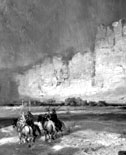|

Comment
on this story
What:
Lure of the West
Where:
The Knoxville
Museum of Art, 1050 World�s Fair Park
When:
Tomorrow, June 14, through Sept. 8, with a
Member's Opening this evening at 5:30 p.m. Scholar Peter Heyl Hassrick will lecture at 2 p.m. on
Sunday, June 23. Call 525-6101 for information on related events.
|
|

The lure of propagandistic art
by Heather Joyner
Most of us know the initial lyrics of "America the Beautiful": O beautiful for spacious skies/ For amber waves of grain, etc., etc. But the 1913 version of the song (Samuel Ward's music with words penned by Katharine Lee Bates) includes less familiar stanzas, such as the following:
O beautiful for pilgrim feet/ Whose stern impassioned stress/ A thoroughfare of freedom beat/ Across the wilderness!/ America! America! May God thy gold refine/ Till all success be nobleness/ And every gain divine!/ Thine alabaster cities gleam/ Undimmed by human tears!/ America! America! God shed his grace on thee/ Till nobler men keep once again/ Thy whiter jubilee!
Call me suspicious if not blasphemous, but given that "America the Beautiful" is the anthem of Manifest Destiny, I find mentions of "alabaster" and "whiter" ominous. What, then, do "Indians" being wiped out as a consequence of Manifest Destiny have to do with the art exhibit opening tomorrow at the KMA? Possibly everything.
Interestingly enough, the first significant migration westward came right through East Tennessee when Daniel Boone made his way from western Virginia into these parts and on to the great beyond (pulling off some slimy land deals as he went). Depicted as a sort of Indian-killing Moses, Boone was painted mid-19th Century escorting settlers through the Cumberland Gap.
That George Caleb Bingham image of Boone is not in the new KMA show, but the art on view from the Smithsonian American Art Museum has the same idealistic feel. It reflects how most non-indigenous people wanted to perceive this period in our country's history, and it often exemplifies a blatant effort to distort history. As art critic Robert Hughes put it in his book American Visions, "Manifest Destiny was America's myth of redemptive violence. It created its own heroes; and art had a large role in promoting it."
Art from the KMA's "Lure of the West" show, however skillful, is not about art, but about message. And most of the time that message comes through loud and clear: Native Americans, whether they are noble savages or just savage, cannot escape the white man's destined dominance—their "enlightened" Christian rule must triumph. Manifest Destiny, then, was a terrific excuse for slaughtering natives who had something the interlopers wanted and for driving into extinction the buffalo they relied on for survival.
Writes Hughes, "Once the whites had won, they could view their defeated enemy through the lens of their art with magnanimous regret—though never with guilt." Not a pretty picture, although the pictures at the KMA are indeed pretty.
Divided into sections with more than 60 works by 31 artists, the "Lure of the West" show includes everything from sublime landscape to artsy Taos School fare. Painting, sculpture, and bronze-relief medallions represent approximately 120 years of art, beginning in the 1820s. Founded in 1846, the Smithsonian Institution not only collected such works but is responsible for the existence of many (via expeditions and commissions it sponsored to boost its holdings).
Dominating the first portion of the 2nd-floor gallery is Albert Bierstadt's massive canvas weighing almost 300 pounds, titled "Among the Sierra Nevada, California." Although the painting is more subtle in terms of color than most other works, it measures 10 feet wide and is nothing if not dramatic. Alpine peaks lifted from Bierstadt's native Europe loom in the distance as a family of deer linger by a lake. Two other Bierstadt paintings are more loosely rendered—as is an oil by Frederic Remington, but most works in this section have the tightness and sheen of earlier images celebrating the post-American Revolution new order. In fact, an unusual multiple portrait of two Pawnee VIPs, painted in Charles Bird King's D.C. studio, resembles portraits of 18th-century noblemen despite the chiefs' tribal trappings.
The middle section of the gallery has a more personal vibe, thanks to George Catlin (an artist who actually lived among different tribes). Anchored by 18 of Catlin's portraits and "scenes" of Native American life, it appears to mark a shift toward less judgmental and politicized imagery.
Nevertheless, alongside Catlin's earnest approach is that of John Mix Stanley. Stanley's creepy "Osage Scalp Dance," in which a white mother begs macho-looking Osage warriors to spare her and her pantless child, echoes the thinly disguised racism seen earlier. Although one tribesman defends her, gang rape—if not death—seems imminent. There's much more to be said about artists like Catlin, but I'll leave that to the museum. Placards produced by curators Nandini Makrandi and Stephen Wicks (in an admirable effort to supplement information in the existing catalog) lend "Lure of the West" added significance.
The most recent art in the show consists mostly of work produced by the "Taos Society," a group attracted to native cultures in the early 1900s. Pre-Modernist painters like Ernest Blumenschein "discovered" the region before artists we now associate with it came along—Georgia O'Keeffe, for instance. Certainly before it became the Taos of today, a town Hughes calls "a high-sierra New Age theme park full of channelers, holistic healers, wanna-be witches, ethnic kitsch dealers, and matched blond lesbians in Jeep Cherokees." Yet Hughes acknowledges that long before World War I, the Southwest had become the center of "mythic American Primitivism," its reality continuously swept away like detritus under a Navajo blanket.
"Lure of the West" has its charms. The artists' use of color alone is impressive, and works should appeal to people of all ages. But I hope the show does more than entertain. I hope it reveals art's power to influence thinking, for good or ill.

June 13, 2002 * Vol. 12, No. 24
© 2002 Metro Pulse
|